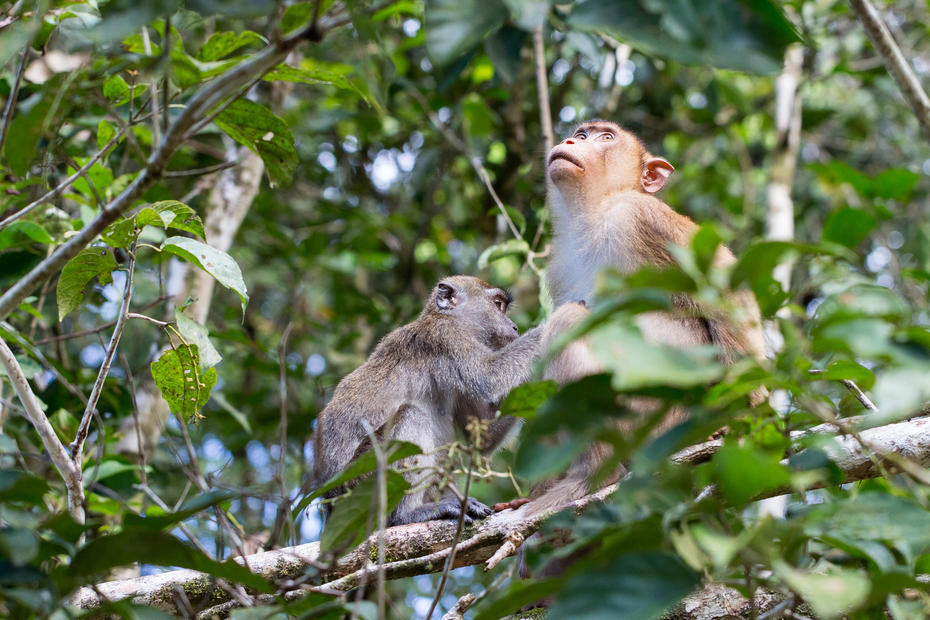Imagine a southern pig-tailed macaque slurping through a fistful of star fruit at the edge of a forest on the island of Borneo.
Every few seconds, the tawny, long-faced primate looks up and scans the area for danger. Clouded leopards prowl here, though not so many as before. These days, humans are the number one threat. People eat monkeys, and it seems every day they push deeper and deeper into the rainforest.
That’s not to say a macaque can’t do well for herself living among people. Sure, humans chop down lots of trees, but then they often plant other trees in their place, ones that produce juicy, delicious fruits. Surviving just becomes a matter of steering clear of their wire snare traps and shotguns.
But the forest contains other hungry creatures that are even harder to avoid: mosquitoes. Our imaginary monkey may swat these tiny pests all day long, but one eventually will find its mark. As the insect’s proboscis pierces the macaque’s skin and extracts blood, yet another danger is drawn onto the stage—the tiny, malaria-causing protozoan known as Plasmodium knowlesi.

Macaques have been a reservoir for P. knowlesi for at least the last 257,000 years. Mosquitos act as public transportation for the parasites, sucking them out of monkeys that have already been infected and injecting them into others along with their saliva. The monkeys, by the way, seem to harbor P. knowlesi without ill effect. We aren’t so lucky. The parasite can be lethal to humans, and infection rates seem to be on the rise in Borneo.
At first blush, P. knowlesi, which is found throughout Southeast Asia, looks like any of the five other species of malaria-causing protozoan, but this one replicates three times faster than its kin. Headache, fever, chills, and cold sweats set in approximately 11 days after infection. Fortunately, P. knowlesi is highly curable. If left untreated, however, it can lead to death. One small study looking at cases between 2006 and 2008 found that approximately one in 10 patients develop “potentially fatal complications.”
It’s impossible to say how long it took P. knowlesi to leap from macaque to man, and perhaps it’s been happening for hundreds of years. What we do know is that the first documented human case occurred in Malaysia in 1965. Since then, the island of Borneo has undergone massive deforestation, and during this period in which scientists have been paying attention, transmission rates have risen. One 2013 study, for instance, found a tenfold increase in cases between 2004 and 2011.
P. knowlesi is currently the leading cause of human cases of malaria in the region. Why people seem to be coming down with it in greater numbers than before has yet to be proved definitively, but a new study published in the February 2016 issue of Emerging Infectious Diseases makes a compelling case that deforestation may have something to do with it. Basically, the researchers found a correlation between the trees coming down and P. knowlesi infections in humans going up.

Note: Correlation does not necessarily mean causation, but the “results strongly suggest a link,” says Kimberly Fornace, a research fellow at the London School of Hygiene and Tropical Medicine and the study’s lead author. “People are moving further into the forests and disrupting areas that may be used by wildlife,” she says. “These changes in spatial overlap between people, macaques, and mosquitoes are important for disease transmission.”
Fornace and her colleagues collected hospital records for P. knowlesi, mapped where the infected people lived using census data, then plotted those locations against satellite records of forest cover.
You may be thinking: Wouldn’t such habitat destruction generally mean fewer monkeys, and thus less chance that the area’s humans would catch malaria from monkey-sucking mosquitoes? Well, this is where things get interesting.
When we cut down rainforest for palm oil plantations or star fruit orchards, the sudden shock to the ecosystem can disperse macaques and other wildlife, temporarily causing a drop in transmission levels. However, this disturbance factor levels out over time, and certain animals are able to re-colonize these areas, sometimes in greater numbers than before. The southern pig-tailed macaque is one of them. (Rats and foxes also thrive on outskirts.)
With macaques, Fornace says that it’s possible the disturbed forest habitats are no longer able to support their populations, so the monkeys might turn instead to raiding crops and other food sources in or near communities. She says farmers in Borneo even tell stories of how monkeys come running at harvest time.
The land’s conversion may lead to changes in human behavior too. It takes a lot of labor to fell a forest, but once it’s cleared, agriculture provides most of the local jobs. All of a sudden, you have more people and macaques in the same area—and the mosquitoes make a feast of them all.
Jimee Hwang, a medical epidemiologist for the Centers for Disease Control and Prevention, says the findings of Fornace and her team support the link between deforestation and the uptick in malaria transmission. “The potential for emerging zoonoses due to habitat changes is a major concern, and continued research to better quantify this relationship is valuable and needed,” says Hwang, who works in the agency’s branch dedicated to malaria.
Fortunately, researchers in Southeast Asia are doing just that. As part of a program called Monkeybar—a large, international effort to understand and address the problem—Fornace and other researchers are creating mathematical models that will try to make sense of how landscape change can affect malaria transmission and perhaps even predict future risk scenarios.
Because when we primates enter the rainforest, we may be wary of the big predators like the clouded leopard, but it’s the little guys that’ll get ya.

This story originally appeared on Earthwire as “Of Monkeys, Men, and Protozoans” and is re-published here under a Creative Commons license.





